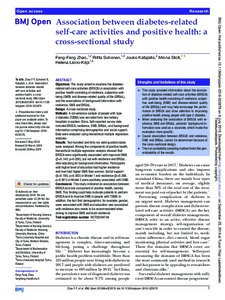Association between diabetes-related self-care activities and positive health: A cross-sectional study
Zhao F.; Suhonen R.; Katajisto J.; Stolt M.; Leino-Kilpi H.
https://urn.fi/URN:NBN:fi-fe2021042822313
Tiivistelmä
Objectives: The study aimed to examine the diabetes-related self-care activities (DRSCA) in association with positive health consisting of resilience, subjective well-being (SWB) and disease-related quality of life (DRQoL), and the associations of background information with resilience, SWB and DRQoL.
Design: A cross-sectional study.
Methods: A convenience sample of people with type 2 diabetes (T2DM) was recruited from two tertiary hospitals in eastern China. Self-reported survey data included DRSCA, resilience, SWB, DRQoL, and background information comprising demographics and social support. Data were analysed using hierarchical multiple regression analyses.
Results: Two hundred and forty-six valid questionnaires were analysed. Among the components of positive health, hierarchical multiple regression analysis showed that DRSCA were significantly associated with improved SWB (β=0.140, p=0.020), but not with resilience and DRQoL after adjusting for background information. Participants with higher level of education had higher resilience and men had higher SWB than women. Social support (β=0.186, p=0.003) in Model 1 and resilience (β=0.298, p<0.001) in Model 2 were positively associated with SWB.
Conclusions: This study indicated an association between DRSCA and one component of positive health, namely SWB. This finding could help motivate patients to perform DRSCA and to improve SWB in people with T2DM. In addition, the fact that demographics, for example, gender, were associated with SWB and education was associated with resilience also needs to be accommodated when aiming to improve SWB and build resilience.
Kokoelmat
- Rinnakkaistallenteet [27094]
